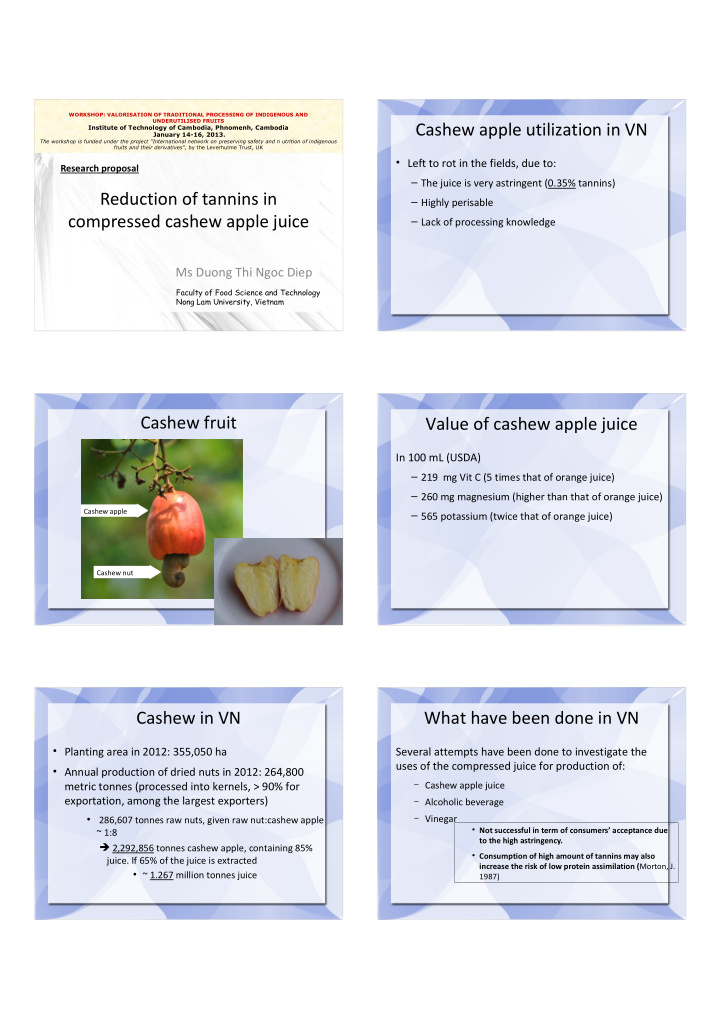



WORKSHOP: VALORISATION OF TRADITIONAL PROCESSING OF INDIGENOUS AND UNDERUTILISED FRUITS Cashew apple utilization in VN Institute of Technology of Cambodia, Phnomenh, Cambodia January 14-16, 2013. The workshop is funded under the project "International network on preserving safety and n utrition of indigenous fruits and their derivatives", by the Leverhulme Trust, UK • Left to rot in the fields, due to: Research proposal – The juice is very astringent (0.35% tannins) Reduction of tannins in – Highly perisable compressed cashew apple juice – Lack of processing knowledge Ms Duong Thi Ngoc Diep Faculty of Food Science and Technology Nong Lam University, Vietnam Cashew fruit Value of cashew apple juice In 100 mL (USDA) – 219 mg Vit C (5 times that of orange juice) – 260 mg magnesium (higher than that of orange juice) Cashew apple – 565 potassium (twice that of orange juice) Cashew nut Cashew in VN What have been done in VN • Planting area in 2012: 355,050 ha Several attempts have been done to investigate the uses of the compressed juice for production of: • Annual production of dried nuts in 2012: 264,800 – Cashew apple juice metric tonnes (processed into kernels, > 90% for exportation, among the largest exporters) – Alcoholic beverage ● 286,607 tonnes raw nuts, given raw nut:cashew apple – Vinegar ● Not successful in term of consumers’ acceptance due ~ 1:8 to the high astringency. � 2,292,856 tonnes cashew apple, containing 85% ● Consumption of high amount of tannins may also juice. If 65% of the juice is extracted increase the risk of low protein assimilation ( Morton, J. ● ~ 1.267 million tonnes juice 1987)
WP2: Tannin removal treatments Objectives of the proposed research – Reduction of tannins/astringency of cashew apple Objectives: juice – Investigate and compare the possibilities of using different techniques to reduce tannins – Maintain/ improve the sensorial properties Techniques to be considered – Retain as highest as possible the nutritional values – Known/published techniques: using starch, gelatin, adsorbent resin (PVP - Polyvinylpyrrolidone, PVPP – polyvinylpolypyrrolidone) (vitamines, minerals) – Other potential techniques: – Precipitation with proteins (?) – Adsorption with modified clay (Arellano-Cardenas et al, 2012, Clays and Clay Minerals 60:153-161 ) (?) – … – Combination of several of the above techniques Process procedure and proposed work WP2: Tannin removal treatments packages Ripened Treatment cashew apples – Addion of varying concentrations of the mentioned agents � reaction � the Compressing clarified juice is separated from the precipitation/slurry by spontaneous settling and/or centrifugation WP1: Characterization Raw juice Biochemical analyses – Treatment parameters: added concentrations, treatment time, pH, temperature of raw juice Evaluation WP2: Tannin removal Treatment & – Reduction in tannins treatments clarification – Retention of other nutrients: sugars, proteins, vitamins, minerals Clarified juice Physicochemical analyses – Yield of the clarified juice WP3: Microrganism – Changes in other physicochemical values: pH, color, turbidity, viscosity … ‘Pasteurizing’ removal – Sensory evaluation (e.g., carried out after pasterization) Clarified & Physicochemical, microbial pasteurized & sensorial analyses juice WP1: Characterization of raw juice WP3: Microrganism removal • Objective: Objectives: – Investigate two methods, namely thermal pasteurization and – Characterization of raw juice, supporting the microfiltration (cold pasteurization), for removal of microorganisms subsequent WPs – Target: to create a safe product with a desired shelf life while • Parameters to be analyzed (according varieties retaining highest quality of the clarified juices. Microfiltration may also help to improve the transparency present in VN, e.g.) Treatment – pH, acidity, color, viscosity – Thermal pasteurization: different temperature/time combinations – Total solids – Microfiltration: pore sizes of the membrane – Concentrations of tannins, sugars, proteins, vitamin C, minerals …
WP3: Microrganism removal Evaluation: – Possible further reduction in tannins – Retention of other nutrients: sugars, proteins, vitamins, minerals – Thank you!!! – Changes in other physicochemical values: pH, color, turbidity, viscosity … – Sensory evaluation – Microbial and physicochemical stability during storage under refrigerating conditions (in bottle) Influences of the work • Utilization of the cashew apples in Vietnam (huge amount, which is underutilized or not ultized at all) • Increase in benefits for farmers, processors • Creation of jobs for local people • The clarified juice can be further processed into other products: blended fruit juice, fermented beverage, vinegar, concentrated juice, fruit powder, … References • This proposal is inspired by a number of published works of researchers in India, Brazil, some African countries, France, and Vietnam
More recommend